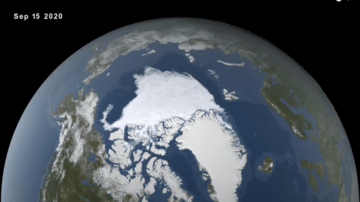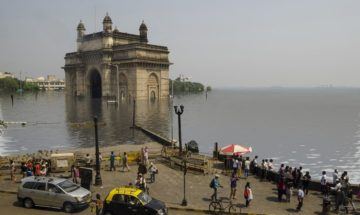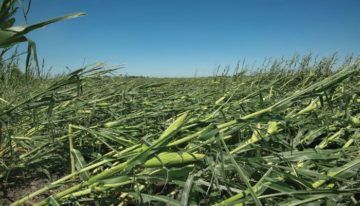by Usha Alexander
[This is the eighth in a series of essays, On Climate Truth and Fiction, in which I raise questions about environmental distress, the human experience, and storytelling. All the articles in this series can be read here.]
 In the late fifteenth century, European seafarers began searching for what they called the “Northwest Passage,” a fabled route across the Arctic Ocean, which would allow them to sail northward from Europe directly into the Pacific in search of fortune. But the Arctic of their time, during the so-called Little Ice Age of the fourteenth to mid-nineteenth centuries, was covered by thick, impenetrable sheets of ice and densely packed icebergs. Nor had they any reasonable expectation that the great mass of ice would soon melt away. That they imagined finding a reliably navigable route through a polar sea seems to me a case of wishful thinking, a folly upon which scores of lives and fortunes were staked and lost, as so many adventurers attempted crossings, only to flounder and often die upon the ice.
In the late fifteenth century, European seafarers began searching for what they called the “Northwest Passage,” a fabled route across the Arctic Ocean, which would allow them to sail northward from Europe directly into the Pacific in search of fortune. But the Arctic of their time, during the so-called Little Ice Age of the fourteenth to mid-nineteenth centuries, was covered by thick, impenetrable sheets of ice and densely packed icebergs. Nor had they any reasonable expectation that the great mass of ice would soon melt away. That they imagined finding a reliably navigable route through a polar sea seems to me a case of wishful thinking, a folly upon which scores of lives and fortunes were staked and lost, as so many adventurers attempted crossings, only to flounder and often die upon the ice.
But now that the Arctic sea ice is melting away, the Northwest Passage has become real in a way the adventurers of old could not have dreamed. Today, nations encircling the Arctic Ocean jockey for control of its waters and territorial rights to newly exposed northern continental shelves, which promise to be full of oil and gas. What had been a deadly fantasy is now a luxury cruise destination flaunting an experience of rare wonder, including opportunities to watch polar bears on the hunt. “A journey north of the Arctic Circle is incomplete without observing these powerful beasts in the wild,” entices the Silversea cruises website, with nary a note about the bears’ existence being threatened by the very disintegration of their icy habitat that makes this wondrous cruise possible. Meanwhile, in China, the emergent northern sea routes have been dubbed the Polar Silk Road, projecting a powerful symbol of their past wealth and influence onto an unprecedented reality.
By now, we’re all aware that the planet is profoundly changing around us: angrier weather, retreating glaciers, flaming forests, bleaching coral reefs, starving polar bears, disappearing bees. Yet how blithely we go on making plans, as though the future will follow as neatly and predictably from today, as today did from yesterday. From buying a new beachside home to booking a cabin in the redwoods a year in advance, the ongoing planetary changes apparently figure little in the plans so many people make. It seems I regularly read articles in which mainstream economists make predictions that entirely disregard the changing climate and collapsing biodiversity, as though these concerns lie beyond our economies. Even governments and corporations who seek to profit from changes like the opening of the Arctic Ocean often presume themselves the drivers of “disruption,” creating new market opportunities in an otherwise stable or predictable world. They don’t seem to recognize that the true nature of what’s upon us might just be greater than they imagine and far more consequential.
Yet the visible changes we already notice in the world are merely harbingers of deeper and more far-reaching changes we don’t yet see—and even changes we might see but don’t pay much attention to. These changes, visible and invisible, will drive further changes; some we might try to predict, but others we won’t—especially those resulting from causes we’re not tracking, including the unknown unknowns.
Canaries in a Coal Mine
 One evening some years ago, I noticed that something about our back patio light looked… unnatural, though I couldn’t say just what about it was odd. Only weeks later did it hit me: the light was absolutely denuded of any cloud of insects that should have been swarming irritatingly around it. Indeed, I don’t remember the last time I saw a moth in or near our home. In the years since I’ve settled in the National Capital Region of India, moths seem to have disappeared from our neighborhood. Gone are the days of periodically cleaning out dead bugs from the light fixtures. Geckos, who used to peek down at us from somewhere near the ceiling or behind wall hangings, are no longer seen or heard. Stately kite hawks circling above, hunting from the updrafts, have nearly disappeared. Parrots, too, have mostly vanished. We used to see great flocks of parrots sweeping across the muted hues of dusk. Or perched like ornamental gems upon the red sandstone relics of Delhi’s lost dynasties. No longer. It seems that the delightfully messy accommodation of nature in Indian urban spaces, which I remarked upon when I first arrived, was failing.
One evening some years ago, I noticed that something about our back patio light looked… unnatural, though I couldn’t say just what about it was odd. Only weeks later did it hit me: the light was absolutely denuded of any cloud of insects that should have been swarming irritatingly around it. Indeed, I don’t remember the last time I saw a moth in or near our home. In the years since I’ve settled in the National Capital Region of India, moths seem to have disappeared from our neighborhood. Gone are the days of periodically cleaning out dead bugs from the light fixtures. Geckos, who used to peek down at us from somewhere near the ceiling or behind wall hangings, are no longer seen or heard. Stately kite hawks circling above, hunting from the updrafts, have nearly disappeared. Parrots, too, have mostly vanished. We used to see great flocks of parrots sweeping across the muted hues of dusk. Or perched like ornamental gems upon the red sandstone relics of Delhi’s lost dynasties. No longer. It seems that the delightfully messy accommodation of nature in Indian urban spaces, which I remarked upon when I first arrived, was failing.
A 2020 report on Indian birds has shown that eighty percent of one-hundred and forty-six well-tracked species are in sharp decline. In North America, bird populations have crashed by twenty-nine percent in the past fifty years. Starvation was responsible for at least one mass die-off of songbirds in the US southwestern desert last year. Worldwide, forty percent of bird species are in decline. It’s not only canaries at risk in our global coal mine. Among land-dwelling vertebrates (including birds), five hundred species are expected to go extinct within the next twenty years—that’s double the rate of extinctions from the previous century, which is already, conservatively, fifteen times the natural background rate of extinction in pre-human times. Forty percent of amphibian species have already been lost over the past hundred years. The picture is even worse for invertebrates. Across the planet, insects from dragonflies to beetles are vanishing. Studies from the UK and US suggest that disappearing populations of moths and butterflies aren’t limited to my neighborhood in India. It strikes me that the tired but often unavoidably apt old expression, “like moths to a flame,” won’t even mean anything to a child under ten. “What’s a moth?” they might ask.
But this concern goes beyond nostalgia. Birds, beetles, geckos, worms, fungi, grasses, microbes—every form of life plays a part in the intricate web that supports us and all living things. Sever too many strands, and the whole edifice of life as we’ve known it will collapse. Is collapsing. But though climate change gets nearly all of the environmental press these days, it isn’t the primary driver of this ongoing loss of biodiversity. The present mass extinction event began before the mass burning of fossil fuels. It’s been driven by overexploitation, habitat destruction, and myriad forms of pollution, including a host of toxic chemicals. It has accelerated aggressively in this Industrial Age.
Since the dawn of agriculture, human activity has reduced the Earth’s total plant biomass by half; plants comprise about eighty percent of global biomass. Since pre-industrial times, wilderness areas have shrunk by seventy-five percent, wetlands by ninety percent. In 2020, the mass of plastic in use was double that of all the animals living on Earth. This figure doesn’t include plastic waste, so it comprises only part of the crisis now dubbed “Global Plastic”: the total infiltration of macro- and micro-plastics into landscapes, oceans, air, and living beings. Artificial waste, industrial and agricultural chemicals have wound their way into the fabric of our planet, into the very bodies of living things, with consequences not yet fully understood, though certainly detrimental to the health of life on Earth. Indeed, the rapid decline of our living world has been so drastic in recent decades that we’re just beginning to come to grips with what we’ve wrought—let alone actively imagine what is truly signified by the changes around us. To reckon with what is unfolding, we must acknowledge that the future world will be very different from the one our ancestors knew—or even the one many of us grew up in.
Redrawing the Maps
The future world will be more barren than the one we’ve known, traveled by fewer animals, both in kind and in number. Fewer birds making a ruckus in the treetops. Dwindling herds of elk and moose, families of lemurs, orangutans, river dolphins, whales, and elephants. Fewer fireflies enchanting a summer night or ladybugs charming the afternoon. No more rhinos. No more polar bears. Every loss of an animal or plant species changes the local balance of life, further destabilizing its ecosystem. Similarly, when forests and meadowlands are fragmented into patches separated by fields or roads, the mix of animals and plants that live within them also changes. Thus, habitat fragmentation or local extinctions can kick off a trophic cascade that alters the very shape of the landscape, even the flow of rivers, the size of lakes, the pattern of rainfall. Due to fragmentation and climate change, the Amazon Rainforest is on the verge of converting to grass and scrubland, with untold consequences for regional weather patterns and agriculture that helps supply the western hemisphere.
Climate change is driving the northward expansion of the Sahara Desert to engulf all of North Africa, jump the Mediterranean Sea, and overtake southern Europe. In the Alps and other mountain ranges, receding glaciers will trigger avalanches and rockfalls, while the Ganga, the Rhine, and other glacier-fed rivers and lakes dwindle. As the familiar icy patch that once adorned the far north of every world map shrinks, the southern reaches of the northern boreal forest and peatlands will burn off, inviting a different mix of trees and grasses to creep northward and occupy the more temperate plains of the former tundra.
 Kiribati, Maldives, and Micronesian states will be engulfed by rising seas. Thus, fewer far-flung islands will dot our maps, exchanged for far greater expanses of unbroken ocean. All the familiar shapes of the continents will take on new contours. Fine beaches from Florida to Maine will wash away, as coastlines everywhere are increasingly inundated and submerged, as hurricanes become more intense and destructive, tsunamis more powerful and lethal. Major cities, including New York, Mumbai, London, Jakarta, and Shanghai will migrate or shrink as decades of steady sea level rise—or a more rapid rise from the loss of the West Antarctic ice shelf—make them increasingly vulnerable to storm surges and tides. So too with long stretches along the coasts of eastern England and northern Europe.
Kiribati, Maldives, and Micronesian states will be engulfed by rising seas. Thus, fewer far-flung islands will dot our maps, exchanged for far greater expanses of unbroken ocean. All the familiar shapes of the continents will take on new contours. Fine beaches from Florida to Maine will wash away, as coastlines everywhere are increasingly inundated and submerged, as hurricanes become more intense and destructive, tsunamis more powerful and lethal. Major cities, including New York, Mumbai, London, Jakarta, and Shanghai will migrate or shrink as decades of steady sea level rise—or a more rapid rise from the loss of the West Antarctic ice shelf—make them increasingly vulnerable to storm surges and tides. So too with long stretches along the coasts of eastern England and northern Europe.
Ways of life or infrastructures built with the expectation of predictable seasonal cycles or climatic conditions will suffer and people will migrate. Nigeria is one region already feeling this, as rain patterns change and deadly conflicts erupt over dwindling water. Globally, conflicts over water have more than quadrupled over the past thirty years. Syria has disintegrated into a failed state, partly triggered by lingering drought that fueled internal migration and political conflict; Central America’s emigration crisis largely results from changed weather patterns. In both cases, the changing climate eroded the agricultural basis of local livelihoods and communities, sparking unrest and violence (though much news reporting elides the climatic causes). Meanwhile, tens of millions of people in southern China and the montane regions of south-central Europe are reeling from the home-wrecking deluges that will continue to plague cities into the future.
 As seasons alter their timing and character, longstanding agricultural centers around the world will wither while new regions spring up. Hotter summers, warmer winters, drought, melting glaciers, and extreme weather already adversely affect the cultivation of strawberries, fruits, nuts, wine, chocolate, coffee, and other everyday foods. The world’s breadbaskets will relocate—or cease to exist—due to changing rainfall, heat, and extreme weather, such as is already squeezing agricultural production in Australia. In just the past year, the United Kingdom, Poland, Romania, Turkey, Pakistan, China, India, Brazil, and the United States, among other nations, have suffered significant crop damage or reductions in yield due to weather or climate. To make matters worse, the rising concentration of atmospheric carbon dioxide is decreasing the protein, iron, zinc, and other essential nutrients in plant foods, making agricultural produce less nutritious. However far-fetched it may seem now, the UN warns that mounting losses to agriculture will increase risks of widespread malnutrition and famine on scales we haven’t seen in half a century, as anticipated this year in Nigeria. Heat waves will intensify to such a degree in some parts of the world—including western and southern Asia—that some currently populated regions may be rendered unsuitable for human settlement. Rising heat in India is already costing tens of billions of hours in lost labor each year, while chronic heat stress is causing a growing epidemic of premature death by kidney failure among farm laborers in India and Central America.
As seasons alter their timing and character, longstanding agricultural centers around the world will wither while new regions spring up. Hotter summers, warmer winters, drought, melting glaciers, and extreme weather already adversely affect the cultivation of strawberries, fruits, nuts, wine, chocolate, coffee, and other everyday foods. The world’s breadbaskets will relocate—or cease to exist—due to changing rainfall, heat, and extreme weather, such as is already squeezing agricultural production in Australia. In just the past year, the United Kingdom, Poland, Romania, Turkey, Pakistan, China, India, Brazil, and the United States, among other nations, have suffered significant crop damage or reductions in yield due to weather or climate. To make matters worse, the rising concentration of atmospheric carbon dioxide is decreasing the protein, iron, zinc, and other essential nutrients in plant foods, making agricultural produce less nutritious. However far-fetched it may seem now, the UN warns that mounting losses to agriculture will increase risks of widespread malnutrition and famine on scales we haven’t seen in half a century, as anticipated this year in Nigeria. Heat waves will intensify to such a degree in some parts of the world—including western and southern Asia—that some currently populated regions may be rendered unsuitable for human settlement. Rising heat in India is already costing tens of billions of hours in lost labor each year, while chronic heat stress is causing a growing epidemic of premature death by kidney failure among farm laborers in India and Central America.
Restructuring Civilization
My sketch of a future world is premised upon geophysical and biospheric changes that are already well underway. And while there are, of course, uncertainties about the future, what we do know for sure is that the situation is already dire. On the matter of planetary heating, alone, we know that in 2019 the global average temperature reached 1.2ºC warmer than the pre-Industrial baseline. The UK Met Office predicts a twenty percent chance we’ll exceed the “safe” threshold of 1.5ºC for at least one year by 2024. A different analysis calculates a seventeen percent chance we’ve already exceeded the carbon budget to remain within the 1.5ºC threshold. Yet another suggests we’d exceed the extreme threshold of 2ºC by 2070, given a modest mitigation scenario in which greenhouse gas emissions don’t increase but remain the same as today. Meanwhile, the extreme effects of global warming are accelerating.
What we can surmise for certain is that our ecological crises—our sustainability crisis—will change how we live on Earth. Within the space of the irreversible damages already underway and our best efforts to avoid more catastrophic damages, it’s inevitable that we’re on the cusp of a global material and social adjustment or renewal. In the best of all remaining possible human futures, we will not continue with the climate or the lifestyle patterns of recent decades; rather, we will undergo a transition of human civilization to accommodate a new climate regime and new ways of life altered for sustainability. Because it’s not only the consequences of global warming and mass extinction that will drive extensive changes. Our most effective means of adequately mitigating global warming and other environmental degradations will themselves propel us into a new world, one in which we’re called upon to change ourselves, undertaking “unprecedented transitions in all aspects of society”, to quote the IPCC SR1.5 report from 2018, produced by an international team of scientists.
By now the most effective strategies for mitigation and adaptation recommended by the IPCC and others are widely discussed, if not as vividly imagined in their everyday repercussions: All nations must fully decarbonize and scale up renewable energy production, storage, and distribution infrastructures at a frantic pace. Just as rapidly move away from chemically intensive farming, deforestation, and destruction of wetlands. The world must identify and preserve between thirty and fifty percent of our land and sea area for untrammeled wildlife habitat. Elevate national and international priorities to construct sea barriers, water harvesting and flood management systems—the wealthier nations aiding the poorer—and also possibly thousands of massive (and as yet unproven) carbon sequestering facilities. As well as cover the costs of mounting disaster recovery and rehabilitation of displaced persons, which will stress the coffers even of wealthy governments and aid agencies. And—not least—dismantle patriarchy to slow population growth, among other excellent reasons.
 All of these necessary actions, at unprecedented speed, scope, and scale will require nothing short of a material, technological, economic, and social reinvention of global culture. It requires us to change our diets: what we eat; how we grow it; where we grow it. It means moving away from meat and animal products grown on the hoof and adjusting to a different mix of locally available fruits and vegetables in any region. It will change what materials we use in construction and to fashion everyday household objects, as we jettison carbon-emitting concrete and petrochemical plastics. It will ultimately require us to recycle everything we consume in order to conserve water and curtail mining, from river sand to metals to the remaining fuel, which must be left in the ground. This in turn will alter what materials and articles we produce and how affordable everyday items remain, right down to the clothes we wear.
All of these necessary actions, at unprecedented speed, scope, and scale will require nothing short of a material, technological, economic, and social reinvention of global culture. It requires us to change our diets: what we eat; how we grow it; where we grow it. It means moving away from meat and animal products grown on the hoof and adjusting to a different mix of locally available fruits and vegetables in any region. It will change what materials we use in construction and to fashion everyday household objects, as we jettison carbon-emitting concrete and petrochemical plastics. It will ultimately require us to recycle everything we consume in order to conserve water and curtail mining, from river sand to metals to the remaining fuel, which must be left in the ground. This in turn will alter what materials and articles we produce and how affordable everyday items remain, right down to the clothes we wear.
The changing climate and necessary lifestyle adjustments will include changes in how and where we live and build our cities, as we abandon unrecoverable infrastructure along some coastal areas. It will affect how far, how often, and the means by which we travel. All these measures will have consequences in daily living. They entail a change in what we value, how we construct and signal social status, what we expect to achieve and how we measure success in our individual lives. What kinds of jobs are available and necessary and esteemed, possibly tilting more in favor of food producers, naturalists, and social workers. Wealth and opportunity will get reshuffled as, over the coming decades, the changing planet fundamentally alters our economies, geographies, geopolitics, societies, and cultures.
Environmental degradation is ultimately driven by overconsumption. If overconsumption is equitably reduced, societies that currently enjoy the most comfortable, “first-world” standards of living with the largest per capita carbon footprints will be the ones who feel their way of life most egregiously altered or curtailed, and those profiting most immediately from the present status quo will be dethroned from their apogees of wealth and power. However, if we don’t undertake adequate measures, the burden will fall first and worst upon the world’s low-income communities and nations. Given this equation, it’s no mystery at all why no meaningful mitigation has yet been undertaken—and likely will continue to be forestalled: privileged individuals and nations are unlikely to vote for policies that dampen their present experience of prosperity. Yet in a scenario where we don’t act aggressively to slow the warming, stanch pollution, and reverse habitat destruction, our world will be increasingly rapidly destabilized, and even the well-off will soon find themselves unable to continue as they are.
Just how much, how fast, and which consequences are more extremely felt by whom depends upon what we as a human community elect and are able to do. Yet too many of us with the most to sacrifice—for it does entail sacrifice by overconsumers—resist the transition. They do so by refusing to acknowledge the need for fundamental socioeconomic change, casting it as unspeakable apocalypse, by deflecting dialog away from deeper changes that are required toward the superficial technical fixes. They limit themselves to arguing about solar versus nuclear power rather than also challenging our culture built around growth economics. But technical fixes alone will never be sufficient to achieve civilizational sustainability. And a deliberate civilizational transition is our best hope to prevent the more apocalyptic scenarios that could actually result from our inaction. The hope—if we can navigate it justly and effectively—is the revival and sustenance of clean air, clean water, wholesome food, and more healthful and equitable living among ourselves and with the planet.
So as the onrushing planetary changes erode the modes of life we presently cling to, we must adapt our lives to more sustainable practices. To do our best, we must squarely face the uncertainty and distress that our predicament presents, recognize the systemic problems, and change the way we collectively live and work, produce and consume. This means disabusing ourselves of our present vainglorious narratives of entitlement. It means dreaming, instead, new stories that kindle new visions of hope, a hope invested not in a “business as usual” future, bedecked with solar panels, but rather in a salutary and equitable transition to new ways of living and thinking and being. For this is the only hope. As António Guterres, the UN Secretary-General, has put it, “Making peace with nature is the defining task of the 21st century.”
[Part 9, Upheaval And Migration]
Earlier Essays in this Series
1 What We Talk About When We Talk About The Weather
Images
1. An image of the Arctic sea ice at its minimum extent in September, 2020, the second lowest on record. The lowest summer sea ice extent, which wasn’t very much lower, occurred in September, 2012. Image by NASA. Public domain.
2. A parrot sitting on an outbuilding at the Qutb Minar in Delhi in 2004. Image by shunya.net.
3. A visualization of Mumbai with 2ºC of global temperature rise. Image by Inhabitat.
4. Corn stalks flattened by a derecho. Over six million acres of corn were damaged in Iowa in August, 2020, along with several massive silos full of stored grain, by this single wind storm that lasted a few hours. Image by Gary Fandel, Iowa Farm Bureau.
5. Women modeling clothing made out of Tensel fabric. Tensel is a fiber made from wood, which the Tensel company says is sustainably grown and manufactured, as well as very soft and versatile. Promotional screenshot.
